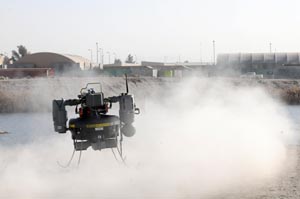
On 14 January a group of soldiers and civilians from coalition forces gathered at the Kandahar Airfield in southern Afghanistan to witness how the Honeywell RQ-16A T-Hawk miniature unmanned aerial vehicle can support combat and security operations throughout the armed forces.
The T-Hawk is already been used for route clearance and by explosive ordinance disposal teams. However, the unmanned vehicle has the capability to do more – operation perimeter security in night and day, as well as reconnaissance missions, providing critical information to commanders in real-time.

Todd Patterson, a field service engineer for Honeywell International, said he would like to see the use of the T-Hawk expanded to every branch of the armed forces. He hopes that a greater number of dismounted troops will have the ability to survey an area before putting themselves in harm’s way.

The T-Hawk features two sensors: one forward and one downward facing camera. These cameras can be interchanged to provide both day and night surveillance.
“The T-Hawk can go from flying straight to hovering over a point of interest,” said Prabha Gopinath, campaign director for Honeywell International. “You can stop and get low to the ground and examine every detail from every possible angle. The sun doesn’t bother it, the dust doesn’t bother it, you can make a very concise determination.”
Managing to weigh less than 20 pounds total, the T-Hawk’s engine can propel the UAV for almost an hour at more than 40 miles per hour.
Reporting from afghanistan: Spc. Jonathon Thomas.



















